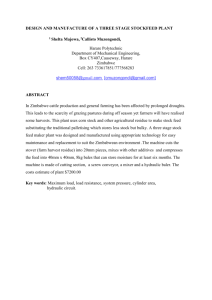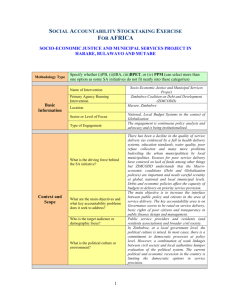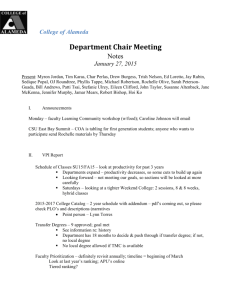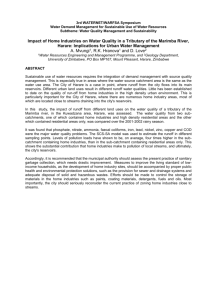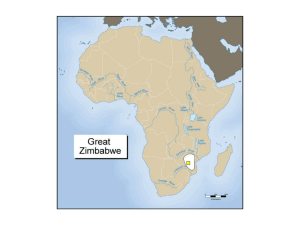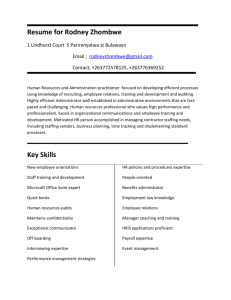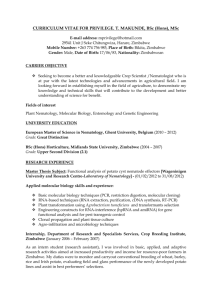Insert logo - The Kubatana Archive Site
advertisement
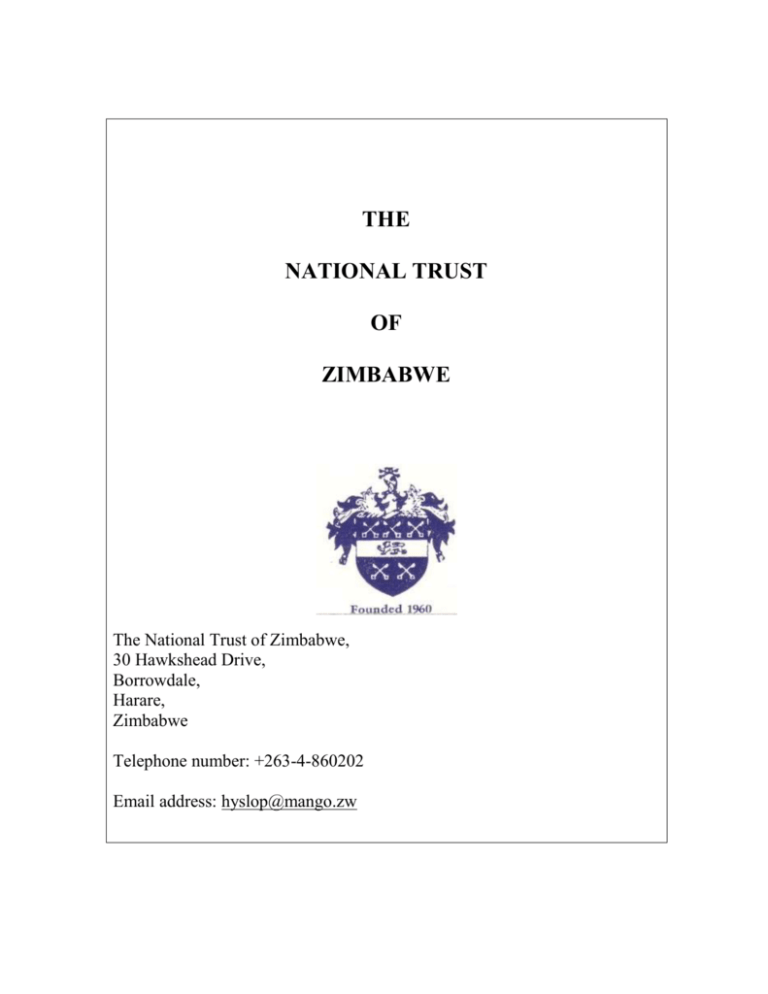
THE NATIONAL TRUST OF ZIMBABWE The National Trust of Zimbabwe, 30 Hawkshead Drive, Borrowdale, Harare, Zimbabwe Telephone number: +263-4-860202 Email address: hyslop@mango.zw 1. INTRODUCTION This booklet provides details about the National Trust of Zimbabwe (NTZ). We hope that you enjoy reading it and become a member in order to take advantage of the many benefits that the NTZ offers. 4. AIMS AND OBJECTIVES OF THE TRUST The aims and objectives of the NTZ are as follows: (a) to accept and hold property in trust for any public purposes and to act in trust for or as Trustee of any property devoted to public purposes in accordance with the conditions of such trust; (b) to promote for the benefit of the people of Zimbabwe the permanent preservation and protection of : 2. HISTORY The National Trust was originally founded in the United Kingdom in 1895 by three Victorian philanthropists - Miss Octavia Hill, Sir Robert Hunter and Canon Hardwicke Rawnsley. Concerned about the impact of uncontrolled development and industrialisation, they set up the National Trust to act as a guardian for the nation in the acquisition and protection of threatened coastline, countryside and buildings. More than a century later the National Trust remains very much alive and a similar sister organization, The National Trust of Zimbabwe was established in 1960 by the National Trust Act. i). ii) Some of our properties are held in perpetuity so that their future protection is secure. The others are open to visitors and we are constantly looking at ways in which we can improve public access and on-site facilities. (c) to provide the public with access to and enjoyment of the lands, buildings, resources and objects mentioned in (b) above; (d) to maintain or manage or assist in maintaining or managing lands and buildings for the purpose of public recreation, entertainment, resort or instruction. 3. GOVERNING BODY The Trust is administered and controlled by a Council consisting of a President and not less than 10 nor more than 20 members of whom not more than 18 are elected at an annual general meeting of members and three are appointed by the Minister of Environment and Tourism. lands and buildings of national, archaeological, historical or aesthetic interest; natural resources, animal or bird life and trees or flora; objects or collections of objects of any description having national, archaeological, historical or aesthetic interest, including furniture, works of art, stamps and literature; 2 5. INTERNATIONAL NATIONAL TRUST ORGANISATION including through education programmes at heritage sites. The NTZ is part of the International National Trusts Organisation (INTO) which is a non-governmental group founded in 2007. INTO was established to promote the conservation and enhancement of the natural and cultural heritage of all nations for the benefit of the people of the world. INTO has close links with organizations such as: UNESCO, UNEP, ICOMOS, IUCN and Europa Nostra. 6. FUNDING Currently, INTO represents about 55 million individual members and countless millions of visitors to sites and properties across more than 25 counties. A part-time honorary secretary and a parttime bookkeeper manage the NTZ’s headquarters in Harare. An external auditor is appointed with the approval of the Minister of Environment and Tourism. Sources of funding for the NTZ include rents, annual subscriptions, donations and bequests, admission charges to properties, hire charges for the use of halls and grounds, and the proceeds of sales of nursery plants and cut flowers. 7. STAFFING INTO and its members are actively involved in various initiatives including: Conserving and enhancing existing built resources, most notably by the viable re-use of historic and older buildings, greening of existing building stock, and reinvestment in older and historic communities; Managing land in a sustainable way; Pilot and implement low carbon technologies; Assisting in the implementation of International Programmes and Conventions, such as the United Nations Framework Convention on Climate Change, the UNEP Convention on Biological Diversity; and the UNESCO World Heritage Committee programme to protect the outstanding universal value, integrity and authenticity of World Heritage sites from the adverse effects of climate change; and Reaching citizens around the world with key messages about climate change mitigation and adaptation, 3 8. MEMBERSHIP BENEFITS Being a member of the NTZ has benefits both inside the country as well as around the world: 8.1 Zimbabwe The Trust has a rapidly growing subscription-paying membership. Members enjoy free entry to all the Trust’s properties in Zimbabwe. In the case of the La Rochelle property, situated in the scenic Imbeza Valley, members are entitled to a 10 per cent discount on accommodation upon production of a valid membership card. Members also receive an electronic newsletter. 8.2 United Kingdom The NTZ has reciprocity with the National Trust of England, Wales and Northern Ireland and the National Trust of Scotland. In terms of arrangements with these Trusts, members are entitled to free admission to all of the many outstanding National Trust properties throughout England, Wales, Northern Ireland and Scotland upon production of a valid National Trust of Zimbabwe membership card. This represents a considerable benefit to members of the Trust who visit the United Kingdom. 8.3 The Trust welcomes new members Please contact us for an application form Email address: hyslop@mango.zw Telephone number: +263-4860202 Worldwide: Through reciprocal arrangements with the National Trusts in Guernsey, Jersey, Barbados, Ireland, Malaysia, Bahamas, Bermuda and New Zealand and with the Australian Council of National Trust’s, and the Stichting het Vrienden der Geldersche Kasteelen and Stichting het Geldersch Landscape in the Netherlands Trust members enjoy free admission to the numerous properties of the National Trusts in those countries. 4 9.PROPERTIES The Trust manages and controls the following properties with the help of its Council, its employees and a number of unpaid volunteers: 9.1 La Rochelle Estate La Rochelle estate is the best known of the Trust’s properties. It is situated in the Imbeza Valley, Penhalonga in the mountainous eastern border area, some 280 km from Harare and 20 km from Mutare. influential politicians, in addition to family members. Most of these distinguished visitors were asked to engrave their signatures with a diamond-tipped stylus on the two large end windows which are of great historical importance. The Courtaulds were patrons of the arts and they funded the building of the Courtauld Theatre, the Queen’s Hall, and the Rhodes Club in Mutare, the Kukwanisa Agricultural School at Watsomba, and the National Gallery and the College of Music in Harare. A small hotel, Rochelle Hotel and Restaurant, operates at the property. Accommodation consists of 6 twin-bedded rooms and 2 double-bedded rooms. There are also self-catering cottages consisting of 1 double-bed cottage and 3 cottages with 5 twin-beds in each 2-roomed cottage. The house was built by Sir Stephen and Lady Virginia Courtauld in 1951 as a retirement home, and was donated to the National Trust in 1970. A leading Professor of Architecture described it as follows: “La Rochelle is a rare example in Africa of a major early Modern Movement (in architectural terms) private house, and almost unique in Zimbabwe, given the quality of its architectural detailing and of its interior decoration, especially in the Fantasia room and the Peacock cottage.” During the time that they lived here, La Rochelle was a Mecca for important local and overseas people from all walks of life, and included artists and film stars, as well as The Hotel offers full English Breakfast, and a Table d'Hote Menu in the evenings. Lunches comprise Light Snack menu, except on Sundays, when a Table d’Hote Menu is prepared subject to advance bookings. To make a booking please contact: P O Box 34, Penhalonga, Zimbabwe, Telephone: Mutare (code 020) 22250 and 0912 306 560 E:mail larochellezim@gmail.com 5 La Rochelle has a large established garden with large areas of unspoiled natural woodland and numerous walking paths. The shade houses are filled with exotic and indigenous orchids. There are interesting exotic trees in the arboretum as well as palms, cycads, azaleas and other flowering shrub. This diversity provides ideal habitats for a large variety of bird species. BLC Alexanderi Alexaderi Vanda Rothschildiana Directions to La Rochelle Opposite Christmas Pass Hotel on the main Harare to Mutare Road, turn left at the Christmas Pass Service Station onto the Penhalonga Road. About 6 km down the road turn right at the La Rochelle signpost and proceed for about 3 km to the La Rochelle entrance on the right. Open: La Rochelle is open every day 6 9.2 Murahwa’s Hill Murahwa’s Hill lies at the base of Christmas Pass on the western edge of Mutare. Traditionally it was been protected in the past as a place of spirits, while latterly the ravages of seasonal fires have been prevented hence the maturity of the many indigenous trees and the unusual variety of microenvironments present. Tambourine Dove, Golden-rumped Tinkerbarbet, Yellow-fronted Tinker-barbet, Whyte’s Barbet, Gorgeous Bush-shrike, Red-capped (Natal) Robin-chat, and Jameson’s Firefinch. Over 200 of Zimbabwe’s 500 species of butterfly are known from Murahwa’s Hill. In addition there are many moths, beetles and dragonflies and much observation and research remains to be done. On the south-western part of the hill there is an early iron age settlement of the Ziwa Period (200-400 AD) with stone-walled settlement higher up that may be associated with the Rozvi Dynasty in its upper levels (late 17th century). The hill is named after a Manyika village-head who was the last local occupant of the site. Over 132 species of trees have been recorded on the property: an exceptionally rich assemblage for such a small area. These comprise Eastern Highlands and Middleveld species, as well as broad range of vines, fungi, mosses and ferns. The diverse microhabitats include closed canopy evergreen forest on the wetter eastern slopes to drier deciduous woodland on slopes facing Christmas Pass. The rocky exposed slopes, ravines, watercourses and granite outcrops all contribute to the diversity of habitats. It is estimated that the larger forest trees are at least 150 years old. Directions to Murahwa‘s Hill: At the fuel filling station as you enter the outskirts of Mutare City on the road from Harare, after crossing over Christmas Pass, turn right and after one kilometre, the entrance gate is signposted and on your right just before the Mutare Agricultural Showground. Open: Murahwa’s Hill opens every day. Bird species include the Silvery-cheeked Hornbill, Trumpeter Hornbill, Livingstone’s and Purple-crested Louries (Turaco’s), 7 9.3Nyanga Historical Exhibition This Exhibition in the Rhodes Nyanga National Park is housed in a double-storied stone building constructed in 1897 and used as stables by Cecil John Rhodes during his visits to the Nyanga area between 1897 and 1900. The displays cover local Manyika culture, early European contacts and the first years of colonial rule, Rhodes and his local influence, the development of the Nyanga tourism and agricultural industries, fallen heroes and tribal chiefs, Chief Tangwena and the struggle for Zimbabwe. Directions to Nyanga Historical Exhibition: Take the Rusape to Nyanga main road for about 90 km where you will see signposts to the Rhodes Nyanga Hotel in the Rhodes Nyanga National Park. The Historical Exhibition is next door to the hotel. Open: The Exhibition is open every day. 8 9.4 World’s View This mist belt area of some 70 hectares is located on the western edge of the Nyanga Downs plateau. From an altitude of 2000m the escarpment drops 600m to the plain below. Directions to World’s View The area is particularly interesting for botanists and ornithologists, comprising of vegetation types associated with either the basal granite or the dolerite cap. There is a toposcope at the property with plaques of black granite showing the direct distances in kilometres to thirty cities, towns and places of interest. In Rusape, turn left (north) onto the Nyanga road. At about 95 km peg just before reaching Nyanga village, turn right onto the Troutbeck Road. At the golf course just before the Troutbeck Hotel (13 km peg) turn left towards the Tsanga Lodge (4 km) and the circular drive towards World’s View (11 km). Open: World’s View is open every day. 9 9.5 Fort Gomo Kadzamu Situated in the Penhalonga district this attractive area of Brachystegia (Miombo) woodland and broken granite terrain is some two hectares in extent. The settlement probably dates to the 17th to the 19th centuries A.D. A small stone fort is located at the top of a hill on the property and is typical of the many fortifications in the eastern half of Zimbabwe that were associated with the Shona Dynasties that postdate the Great Zimbabwe culture. Directions to Fort Gomo Kadzamu On the main road from Harare to Mutare, turn left (north) opposite the Christmas Pass Hotel onto the Penhalonga road. Pass through this village and past the gold mine dumps and eucalyptus plantations. Fort Gomo Kadzamu is on the right at the 26 km peg at the turn-off to the Stapleford Forestry Estate. Open: Fort Gomo Kadzamu is open every day. 10 9.6 Mabukuwene This property (Mabukuwene means ‘the look-out‘ or “high place) consists of 12 hectares of natural and unspoiled wilderness with a high point of 1,422 m above sea level on a rocky outcrop a few kilometres south of Bulawayo City centre.. There is a small, picturesque thatched hall available for weddings, lectures and other functions. Directions to Mabukuwene: There are some 80 different species of indigenous trees including some particularly fine specimens of Ficus and Euphorbia with many aloes and other succulents. When in flower they attract a wide variety of birds, nearly 100 species of which have been recorded Proceed south along Robert Mugabe Way which becomes Hillside Road, pass through Bradfield and Hillside, and look out for Inverleith Drive into which you turn right to reach the entrance to Mabukuwene in Burnside about 5 km from the City Centre. Open: Mabukuwene is open every day. 11 9.7 Sebakwe Poort Park This 262 hectare property is situated near Kwekwe. It is essentially an area of natural and unspoiled woodland comprising a large number of species of indigenous trees, including many fine specimens of several different Acacia species. The Sebakwe River flows through the property and the poort, or gorge, is an impressive sight. Please feel free to contact us for any further information that you may require about the Trust and its properties . Share and experience with us the interest and beauty of these important sites, both in Zimbabwe and worldwide. Directions to Sebakwe Poort Park: From the main Harare to Bulawayo Road on the Harare side of Kwekwe, at about the 205 km peg, turn right (north) onto the Gokwe Road. Proceed about 10 km following the Sebakwe Poort signs not the Sherwood and Tiger Reef signs. Open: Sebakwe Poort is open every day. Photographs courtesy of: Mr. D Plowes and Mr M Kimberly 12

